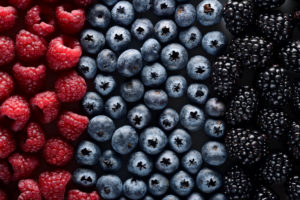
Сolorful flag with fruits of the forest
Blueberries have long been identified as one of the top “superfoods” out there. A rich source of polyphenols—which give them their deep purple/blue hue—blueberries have become a healthy-diet staple. But there are plenty of other blue or purple foods that may also boost your health in a number of ways.
As mentioned, polyphenols give blue and purple food its color. One particular polyphenol, however, gives these deep hues some serious power. Anthocyanins, a type of polyphenol, are associated with several health benefits including better heart health, lower risk of obesity, type-2 diabetes, and perhaps even offer support as a natural remedy for the cold and flu. Some other powerful blue/purple “superfoods” include:
Elderberries:
One of the most popular plant remedies worldwide, these bluish/purple berries may offer a strong defense against cold and flu. Elderberries may have the potential to act as immune-system boosters, reducing the likelihood of infection or shortening the intensity and duration of cold and flu symptoms. Research has indicated elderberry may activate the immune system to fight off these viruses. There is also studies to suggest that taking elderberry syrup daily can shorten the duration of flu by four days. If you want to try elderberry, cook it first. If eaten raw, it can lead to negative reactions in the stomach.
Blackberries:
Blackberries are one of the densest sources of vitamin K available, as well as being very high in fiber, vitamin C, and manganese. Each of these compounds provides healthful benefits including immune health, heart health, digestive health, bone health, and more. One cup of blackberries features eight grams of fiber, 40 percent DV of manganese, 34 percent of your vitamin, and nearly a quarter of your vitamin K.
Blueberries:
It’s hard to avoid mentioning blueberries again. They are a rich source of nutrition and anthocyanin that can help protect cells from harmful free radicals. One study in healthy men suggested that eating two cups per day was able to protect DNA from free radical damage. Blueberries can be added to yogurt, salads, oatmeal, or eaten raw.
Including a variety of polyphenol-rich foods may help improve your health in a number of ways, so try to mix up your berries from time to time! If berries aren’t your thing, you can also get anthocyanin from grapes, plum, blue tomato, and eggplant.